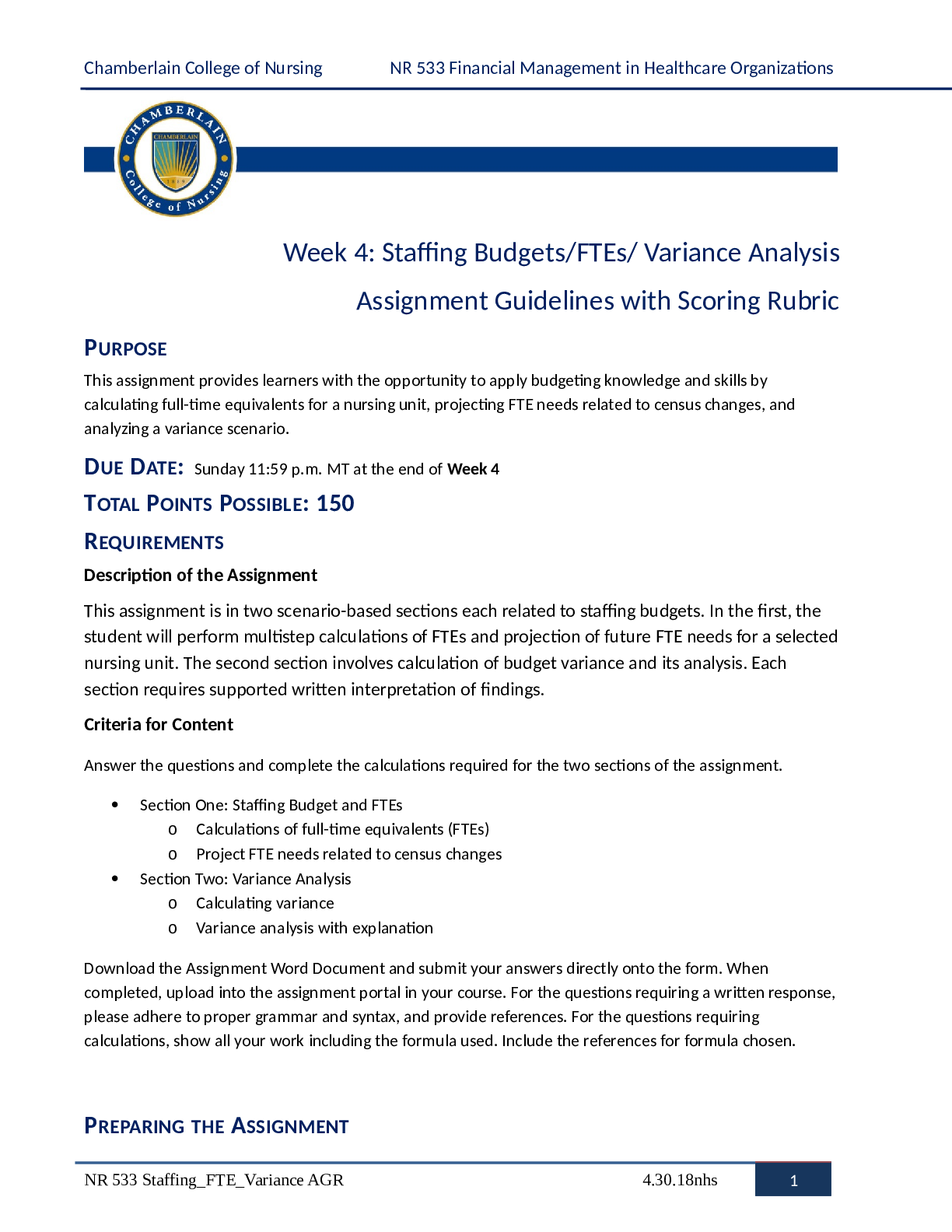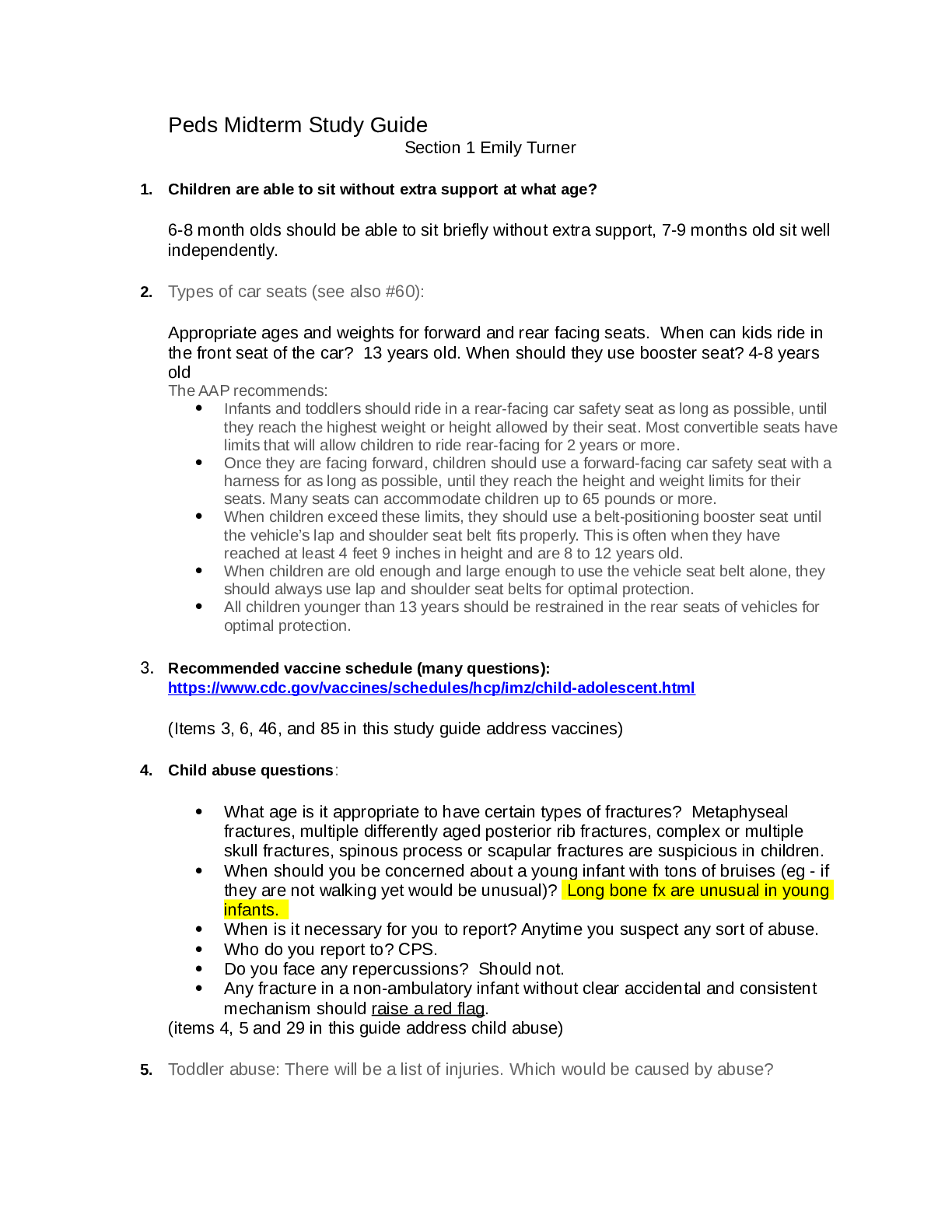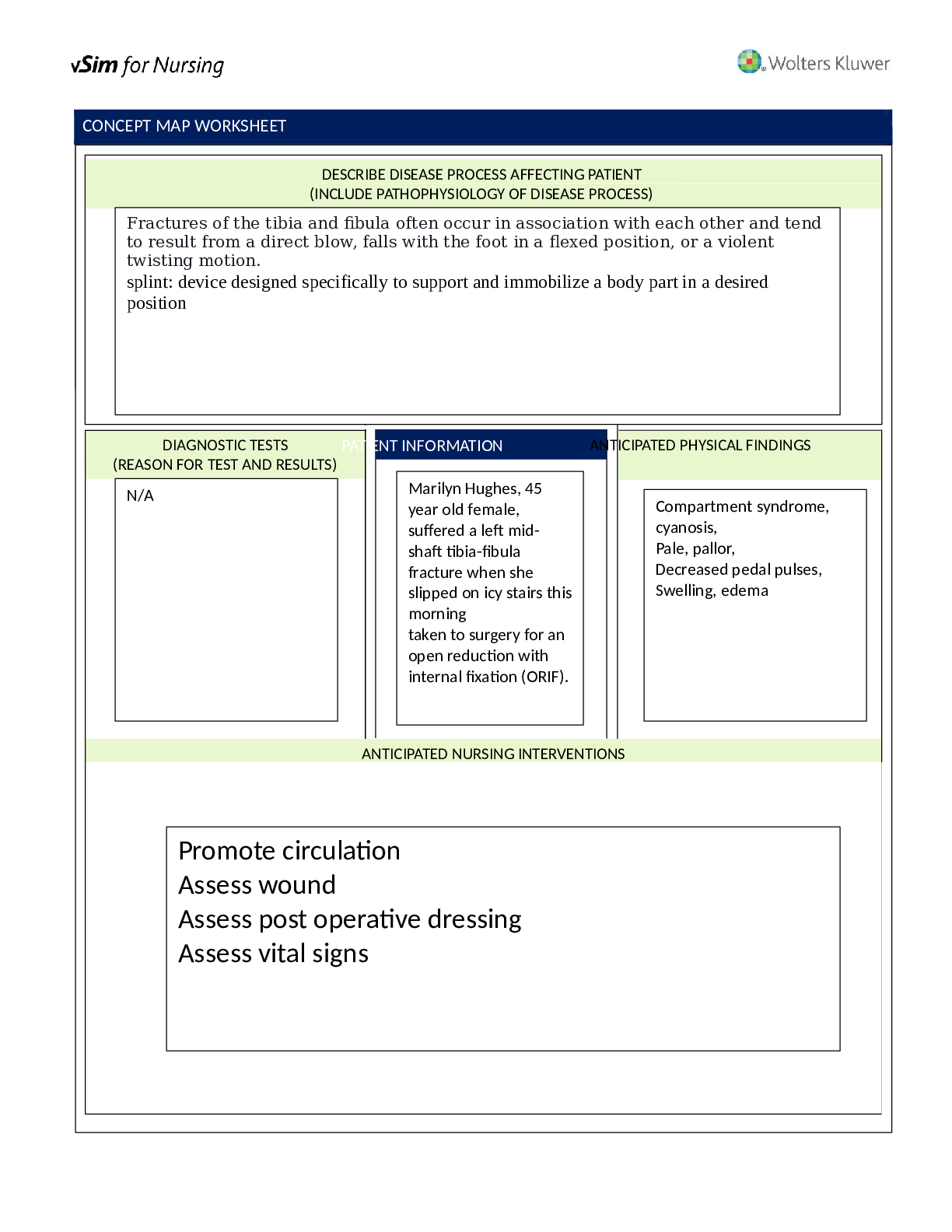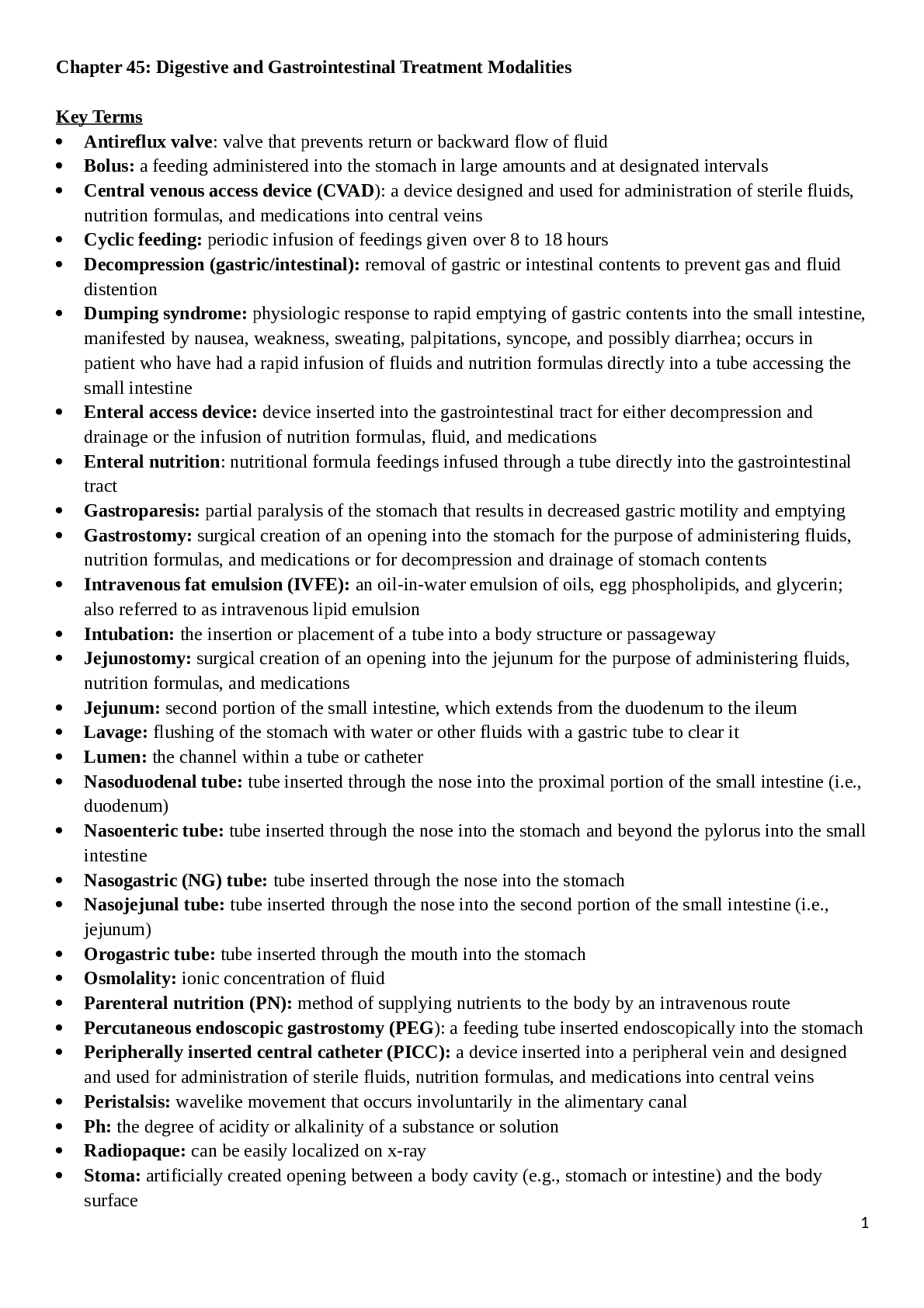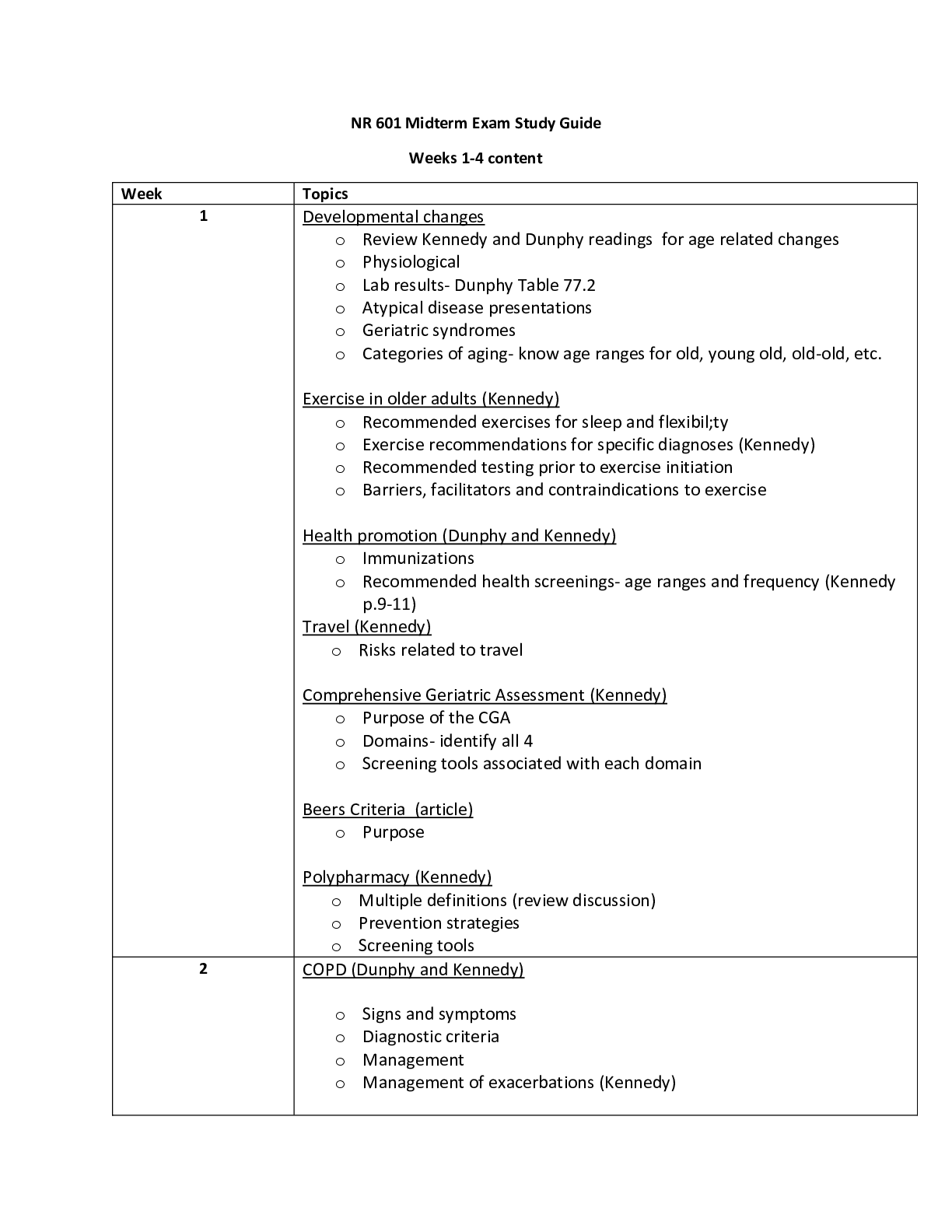*NURSING > STUDY GUIDE > NURS 6630 MIDTERM EXAM STUDY GUIDE LATEST 2022-2023 (All)
NURS 6630 MIDTERM EXAM STUDY GUIDE LATEST 2022-2023
Document Content and Description Below
NURS 6630 MIDTERM EXAM STUDY GUIDE Non-compliant patients Neurotransmitters- are chemical messengers that allow signals to cross synapses to transmit information from a nerve cell or neuron... to a target cell. Nerve transmitters coordinate behavor by stiulating an action or inhibiting an impulse. Example of neurotransmitters: dopamine. Used by the brain to help regulate breathing, heartbeat, and digestion. It can also affect concentration, sleep, and mood. Neurons- have many sizes, lengths, and shapes that determine their function based on where they are in the brain; and are the cells of chemical communication in the brain. Human brains are comprised of tens of billions of neurons, and each is linked to thousands of other neurons. Thus, the brain has trillions of specialized connections known as synapses. * The anatomically addressed brain is thus a complex wiring diagram, ferrying electrical impulses to wherever the “wire” is plugged in (synapses). **When neurons malfunction behavioral symptoms may occur. When drugs alter neuronal function, behavioral symptoms may be relieved, worsened, or produced. Neurons are some of the longest-lived cells in your body; neurons are irreplaceable, and neurons have huge appetites (glucose and appetites). Neurons transit signals when stimulated by sensory input or triggered by neighboring neurons. Gene Expression Cytochrome P450 Enzyme System Pharmacokinetics- the way the body does to the drug. Mechanisms of receptors including: G-Protein linked receptors- (see notes) nicotine cholinergic Serotonin- present in the brain and digestive tract; inhibitory neurotransmitter has been identified as an important factor in mood, depression, anxiety, sleep, emotions, and regulation in appetite and temperature. Serotonin imbalances are involved in depression, impulse behavior, sleep, and emotional disorders. Dopamine- functions as both an inhibitory and excitatory neurotransmitter; critical for memory and motor skills. (Behavior, learning, sleep, mood, focus, attention, immune health, and pleasurable rewards). Ex: excessive amounts are linked to schizophrenia- a long term psych disorder of a type involving a breakdown in the relation between thought, emotion, and behavior; also linked to addictive or impulsive behaviors. Norepinephrine- widely distributed throughout the body, acts as a neuromodulatory optimizing brain performance; as part of the bodies flight or fight response, it quickly provides an accurate assessment of danger or stressful situations. Obsessive amounts of this chemical, especially when no actual danger exists can lead to anxious and hyperactive. Epinephrine- widely known as adrenaline; is both a neurotransmitter and hormone that is essential to metabolism, attention, focus, stress, fear, anger, panic, and excitement. Abnormal levels of epinephrine are linked to sleep disorders, anxiety, hypertension, and lowered immunity. Acetylcholine- this widely distributed excitatory neurotransmitter was the 1st to be identified, and triggers voluntary muscle contraction, controls heartbeat, and stimulates hormones; enables muscle action, learning, and memory; research NURS 6630 MIDTERM EXAM STUDY GUIDE suggest that ACH may be critical for sleep, attentiveness, sexuality, and memory. Ex: Alzheimer’s patients have a deterioration in their acetylcholine neurons. GABA (y-aminobutyric acid)-as the major inhibitory neurotransmitter widely distributed through the brain; GABA is considered a significant mood modulator. When GABA levels are too low or GABA action is impaired, neurons can become overexcited which can lead to restlessness, anxiety, or irritability. Glutamate- the most common neurotransmitter in the central nervous system; glutamate is an excitatory relative of GABA that is involved in most aspects of brain functioning, including cognition, learning, memory, and is considered a major mediator of the excitatory signals, regulating the brain development as well as the elimination and formation of nerve synapses. D2 receptors glycine receptors ionotropic receptors Hormones- chemical messengers that are manufactured by the endocrine glands, travel through the bloodstream, and affect other tissues. They are chemically identical to some neurotransmitters (Control: attraction, appetite, and aggression) While the nervous and endocrine system are similar that they produce chemicals destined to hit up certain receptors; they operate at different speeds. (Ex: if nervous system wants to get in touch with you- sends a text; endocrine system- send through the mail). *** 6 key neurotransmitter systems targeted by psychotropic drugs: serotonin, norepinephrine, dopamine, acetylcholine, glutamate, and GABA. Stahl’s Essential Psychopharmacology Chapter 1 – Chemical Neurotransmission Anatomical versus chemical basis of neurotransmission What is neurotransmission? Neurotransmission can be described in many ways: anatomically, chemically, and electrically. The anatomical basis of neurotransmission is neurons and the connections between them, called synapses, sometimes also called the anatomically addressed nervous system, a complex of “hardwired” synaptic connections between neurons, not unlike millions of telephone wires within thousands upon thousands of cables. The anatomically addressed brain is thus a complex wiring diagram, ferrying electrical impulses to wherever the “wire” is plugged in (i.e., at a synapse). Synapses can form on many parts of a neuron, not just the dendrites as axodendritic synapses, but also on the soma as axosomatic synapses, and even at the beginning and at the end of axons (axoaxonic synapses). However; such synapses are said to be “asymmetric” since communication is structurally designed to be in one direction. Neurotransmitter is packaged in the presynaptic nerve terminal like ammunition in a loaded gun, and then fired at the postsynaptic neuron to target its receptors. General structure of a neuron: All neurons have a cell body known as the soma, which is the command center of the nerve and contains the nucleus of the cell. All neurons are also set up structurally to both send and receive information. Neurons send information via an axon that forms presynaptic terminals as the axon passes by (en passant) or as the axon ends. Neurons also receive information through dendrites (spines on dendrites, and often [Show More]
Last updated: 2 years ago
Preview 1 out of 14 pages

Buy this document to get the full access instantly
Instant Download Access after purchase
Buy NowInstant download
We Accept:

Reviews( 0 )
$15.00
Can't find what you want? Try our AI powered Search
Document information
Connected school, study & course
About the document
Uploaded On
Nov 04, 2022
Number of pages
14
Written in
Additional information
This document has been written for:
Uploaded
Nov 04, 2022
Downloads
0
Views
120

